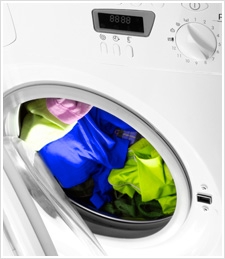A Quick Guide To: Washing Machines
February 18, 2015 | Washing Machines | No comments
 Whilst the washing machine is an important appliance within the home, how many of us actually know how a washing machine works, enabling us to fix it should a fault occur.
Whilst the washing machine is an important appliance within the home, how many of us actually know how a washing machine works, enabling us to fix it should a fault occur.
However, at BuySpares we understand the importance of having a basic understanding of our appliances, which is why we’ve provided this quick guide to washing machines, which looks at three of the most common questions asked.
How to Install a Washing Machine:
Installing a washing machine within your home is a simple and straightforward task, especially if you’re connecting it to an existing water supply.
Once you’ve made sure the location of the appliance has been correctly prepared, fit isolation valves to your washing machine. These will enable the appliance to be isolated without the need to cut off the cold water supplies should a fault occur.
With the valves connected, attach the waste hose to the trap at the top of the standpipe, followed by the hot and cold water hoses to the respective pipe-work.
With everything connected, it’s important to make sure you check all connections for signs of leaks. If everything seems OK, plug the machine in and begin a quick wash cycle to make sure the water fills the machine and drains away OK.
How Does a Washing Machine Work?
Understanding how your washing machine works will help you diagnose any faults and fix them; and the basic working functions of a washing machine remain the same, whatever make and model you have – as explained below.
Step 1: A switch in the door lock tells the machine to lock the door and for the programme to start.
Step 2:With the door locked, most machines will carry out a self test of the motor and heater circuits. If no issues are found, the control panel will inform the water valves to fill the machine through the detergent dispenser picking up detergent along the way.
How much the drum is filled, will depend on the programme selected.
Step 3: If the correct water level is detected during the designated time (usually 2 minutes), the machine will start the wash programme. The first process is to tumble the laundry in the water and detergent.
Should a heated wash have been selected, the heating circuit will be turned on until the correct temperature is reached. After this point, the wash will continue.
Step 4: At the end of the wash cycle, the drain circuit is activated and water drained away. Once the water has drained, most machines provide a quick tumble and spin to remove any remaining dirty water, before a rinse cycle is carried out to remove detergent from the load.
NB: Some machines repeat the drain and spin cycle, before giving a second (and sometimes third) rinse cycle.
Step 5: Following the rinse cycle, the washing machine will slowly tumble the wet washing until it layers itself as evenly as possible around the drum.
How to Clean Your Washing Machine:
When it comes to cleaning your washing machine, there are a few key areas which we would recommend you focus on. These include the detergent drawer, door seal and filters.
Firstly, if bacteria is allowed to build up within the detergent drawer your appliance will begin to emit an unpleasant odour. Cleaning the drawer is a straightforward task, as outlined in our “How to Remove and Clean Your Washing Machine Soap Drawer” article.
The door seal can also harbour bacteria which can result in unpleasant odours; but as with the detergent drawer, cleaning the seal is an easy task. Simply run a clean, hot cloth over the seal, making sure to get into the crevices to remove any dirt and bacteria build up.
Finally, the filters on your washing machines; if these become blocked then you may experience issues with your machine draining or the drum spinning. As with the two parts above, cleaning the filters is a relatively easy task and we’ve provided a guide in our “How to Remove and Check a Washing Machine Filter” article.
In addition to cleaning individual parts on your washing machine, to help keep the appliance running to its full potential, we recommend carrying out regular service washes with a limescale and detergent remover. By carrying out such a wash, you’ll help ensure that the internal components of the appliance, which you cannot normally get to, are cleaned.
For more tips on how to maintain your washing machine to ensure that it works efficiently for longer, read our blog “Five Super Tips to Maintain Your Washing Machine”. Alternatively, visit our advice centre, which is packed with helpful advice to keep your appliance running.
Tags: Washing Machine Maintenance, Washing Machine Spare Parts






